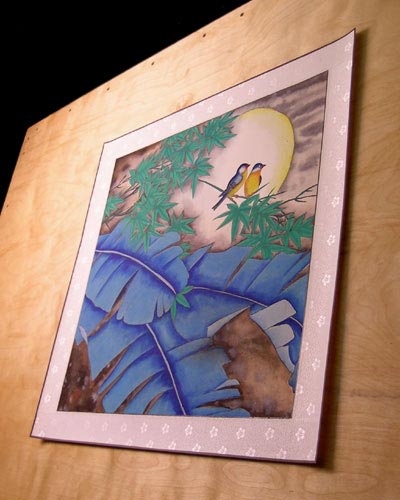Notes about Asian art images on our website:
I try my best to take accurate pictures in our photo studio.
These images are balanced using PhotoShop and optimized to make them load faster on the web.
Also to make pages load faster for our customers on 3G internet access, we use one small tile image of the silk border as the background of the paintings we sell.
This practice doesn't always produce the most accurate presentation, but makes our artwork pages load 25% faster.
Since we sell artwork, presenting large accurate pictures is important to us.
But you should note that because of some issues discussed here, and the fact that different types and models of computer monitors will show colors and shades differently, the artwork may appear slightly different in real life than it does on our online Asian art gallery.
How Your Asian Watercolor Painting is Mounted
Below you will find information on what to expect when you buy and receive your watercolor painting/portrait from our gallery.
This information applies only to artwork mounted with a silk border.
It does not apply these categories: Philosophy Art, Modern Art, Folk Art, Batik Tapestry Wall Hangings, or Charcoal Drawings.
About Asian Art Mounting & Framing:
How Wall Scrolls Are Made
(a tour of our Asian art workshop)
Hanging and Caring For Your Wall Scroll
Info About Framing Asian art
Step-By-Step Guide: Framing Asian Art


This is what you receive from our gallery.
A nice painting with a silk border.
Your artwork arrives ready to frame yourself,
or better yet, take to your favorite professional framer
to complete the presentation.
Why is Asian Art different?
When you deal with an oil painting, it is usually on a cloth canvas, and needs to be stretched on a wood frame.
In the western world, watercolor paintings are generally done on thick paper which can be dry-mounted or pressed flat and framed
Asian artwork is different! Here is the typical situation:
A piece of artwork or calligraphy is painted on a thin sheet of  (xuan paper)
(most people call this rice paper - though it actually does not contain any rice).
(xuan paper)
(most people call this rice paper - though it actually does not contain any rice).
Note that sometimes xuan is spelled "shuan" in Taiwan and in some books about Asian art. However, "xuan" is considered the correct transliteration or Romanization in mainland China.
The painting is then mounted (laminated) to a few more sheets of xuan paper, and some silk brocade cloth is also laminated around the outside of the artwork.
In better mounting workshops, the mounters will also add a dark brown keyline between the edge of the artwork and the inside edge of the silk. They will also add more keyline tape on the outside edge of the whole piece. The main function of the keyline tape on the outside edge is to make the artwork look nice before you frame it (though this edge will be hidden by your frame when complete).
The silk cloth becomes the border of the artwork. When you go to frame your painting, you have the choice of using this silk as a very traditional Chinese-looking matting, or to have your framer cover this silk with western-style matting.
HELP ME! Sometimes people traveling in China buy some unmounted artwork. They often think you can just have a professional framer mount the artwork and frame it. It's not so easy, as most framers have no idea what to do with this kind of artwork when it's not already been mounted.
If this is your situation, just contact me. I'll try to rescue you. I can mount your artwork at my workshop in Beijing, and return it to you for a reasonable cost.